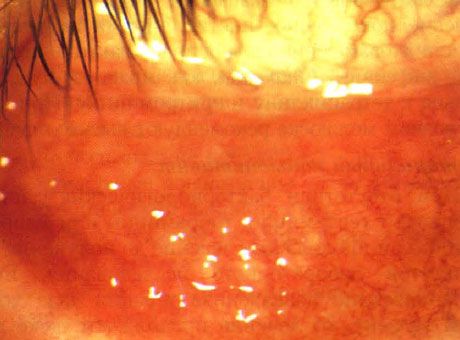Medical expert of the article
New publications
Acute conjunctivitis in children
Last reviewed: 07.07.2025

All iLive content is medically reviewed or fact checked to ensure as much factual accuracy as possible.
We have strict sourcing guidelines and only link to reputable media sites, academic research institutions and, whenever possible, medically peer reviewed studies. Note that the numbers in parentheses ([1], [2], etc.) are clickable links to these studies.
If you feel that any of our content is inaccurate, out-of-date, or otherwise questionable, please select it and press Ctrl + Enter.
Acute catarrhal conjunctivitis
Clinical characteristics
- Conjunctival injection.
- Lacrimation.
- Separable.
Microflora
- H. influenzae.
- Strep, pneumoniae.
- Z.Moraxella (conjunctivitis of the outer corner of the eye).
- Neisseria spp.
- Chlamydia in older children and adolescents.
 [ 1 ], [ 2 ], [ 3 ], [ 4 ], [ 5 ], [ 6 ], [ 7 ]
[ 1 ], [ 2 ], [ 3 ], [ 4 ], [ 5 ], [ 6 ], [ 7 ]
Acute follicular conjunctivitis
Epidemic keratoconjunctivitis (EKC)
Epidemic keratoconjunctivitis is a highly contagious disease characterized by redness of the eyeball, lacrimation and often combined with keratitis. Concomitant keratitis, as a rule, is characterized by a mild clinical course (delicate epithelial and subepithelial opacities on the periphery of the cornea). Multiple follicles appear in the conjunctival fornices. Sometimes the disease is accompanied by an increase in temperature. The main causative agent of the process is adenovirus. Treatment does not always bring the desired effect, but the administration of steroid solutions helps to alleviate the symptoms. Patients require careful observation. Antibiotics are prescribed to prevent the development of a secondary bacterial infection.
Pharyngoconjunctival fever
Pharyngoconjunctival fever is a form of infectious conjunctivitis, usually of adenoviral origin, accompanied by fever, pharyngitis and lymphadenitis.
Keratoconjunctivitis due to herpes simplex virus
This form of conjunctivitis usually occurs in older children, but sometimes occurs in newborns and young children.
Symptoms include redness of the eye, lacrimation, discharge, itching, injection of capillaries, vesicular rash on the eyelids and lymphadenitis of the preauricular lymph nodes. Involvement of the cornea in the inflammatory process is manifested by various forms of keratitis - epithelial, dendritic, discoid and stromal.
Treatment consists of prescribing idoxuridine ointment and acyclovir. It is advisable to examine the state of the immune system.
Hemorrhagic conjunctivitis
The disease manifests itself in multiple hemorrhages under the conjunctiva, a feeling of "sand" in the eyes, redness of the eyeball, and lacrimation. The most common pathogens are Picornavirus and Coxsackie virus. The duration of the process usually does not exceed several days. No treatment is required.
Acute conjunctivitis in general diseases
- Chlamydia.
- Chickenpox.
- Lyme borreliosis.
- Flu.
- Epstein-Barr virus.
- Parinaud's syndrome is an oculoglandular syndrome (conjunctivitis combined with lymphadenitis).
- Sweet's syndrome - fever, arthritis and pseudovesicular skin rashes.
Membranous conjunctivitis
The diagnosis of membranous conjunctivitis is made when there are false films on the surface of the conjunctiva. The disease occurs when:
- Stevens-Johnson syndrome;
- toxic epidermal necrolysis;
- herpes simplex virus;
- herpes zoster,
- Corynebacterium diphtheriae;
- Strep. pyogenes;
- Staph. aureus;
- Neisseria spp;
- Shigella;
- Salmonella;
- E. coli.
Infantile folliculosis
Many healthy children have follicles in the conjunctival fornices, a condition called folliculosis (Figure 5.12).

Acute follicular conjunctivitis in a child with multiple lesions of molluscum contagiosum
Subacute and chronic follicular conjunctivitis
- Conjunctivitis of the outer canthus caused by Moraxella.
- Molluscum contagiosum.
- Tuberous conjunctivitis.
- Drug-induced conjunctivitis: Instillation of medications, especially those containing preservatives, can cause conjunctivitis.
- Rosacea (rarely seen in young children).
- Blepharoconjunctivitis.
Research
If necessary, scrapings are taken from the conjunctiva for subsequent Gram staining, sowing and determination of the sensitivity of the isolated flora. Sowing is performed to exclude the fungal and viral nature of the disease.
Where does it hurt?
What do need to examine?
How to examine?
Treatment of acute conjunctivitis in children
If bacteriological examination data are available, treatment with appropriate drugs is administered. In acute follicular conjunctivitis, symptomatic treatment is usually prescribed, supplemented by instillations of tobramycin or chloramphenicol to prevent secondary infection. Chlamydia is usually sensitive to tetracycline and erythromycin. In molluscum contagiosum, curettage is recommended.
Catarrhal conjunctivitis
In the absence of bacteriological data, gentamicin, tobramycin or chloramphenicol are prescribed and treatment is continued until laboratory test results are obtained. If the initially prescribed therapy has produced a good effect, then treatment is continued even if there is a discrepancy with the results of the bacteriological examination.

